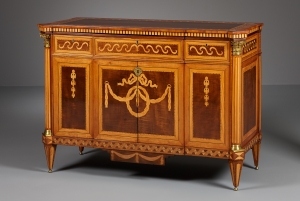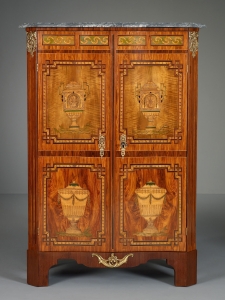Dutch Louis XVI Klapbuffet
Dutch Louis XVI Klapbuffet
The protruding front and the adjacent panels are decorated with classical vases. Together they form the two doors of the buffet. The corpus rests upon tapered legs that end in bronze spheres. The corners are decorated with glyphed columns that end in gilt bronze Corinthian capitals. Above the doors two drawers and a front are decorated with inlays of curling Acanthus. The top is elaborately decorated with a flower-motive.
When the top is turned up, a pewter basin appears. The mahogany panels on either side can be extended to the sides to enlarge the workspace. The inside of the countertop has two foldaway shelves.
This striking buffet belongs to a group of as yet four buffets which on basis of of construction and decoration can be ascribed to one and the same atelier.
This buffet is the most profound one of this small group. In workmanship this buffet can be considered as a revelation between the large amount of buffets which were made at the end of the 18th century.
These so –called ‘klapbuffetten’ were typical Dutch. This type of multifunctional furniture resembled when closed a commode, but it opens to reveal a basin of pewter, which made it highly suitable for serving meals or to rinse wine-glasses.
Literature
Clémentine L. Diepen, In de muur, uit de muur, ontwikkeling van vorm, decoratie en functie, Buffetten in de 18e eeuw, Utrecht 2006.
- Period
- ca. 1795
- Material
- oak frame veneered with satinwood, tulipwood, sycamore, mahogany and kingwood.
- Dimensions
- 93 x 62 x 137 cm
Global shipping available










